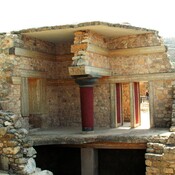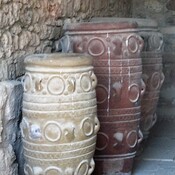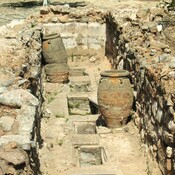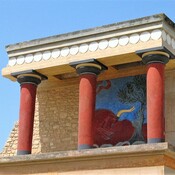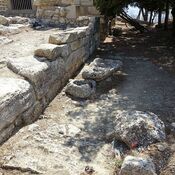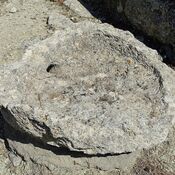Es gibt noch keine deutschsprachige Anmerkungen. Präsentiert wirden Anmerkungen auf English.
The three chambers and an antechamber of the temple. Text and photo fromUK.Digiserve.com
The site was excavated by J. Sakellarias in 1979. It turned out to be one of the most significant excavations in Crete. The temple was destroyed early in the 17th century BC, as examples of MM II and MM IIIA pottery styles were found in the temple. It was destroyed by an earthquake. A skeleton of a man was found in the antechamber. He had been holding a vase, possibly containing blood. The position of the body suggests that the person was running from the building when it collapsed and killed him.
In the west room (on the right of the photo) three skeletons were found: a man and a woman, who had been killed by the earthquake -- and a male skeleton lying on an altar. Its feet had been tied. A knife was resting on the skeleton. His body had been partially drained of blood when the earthquake struck. Apparently the young man had been sacrificed.... The site is fenced in and not generally open to the public.
This portentious archeological discovery has been attacked by many people - yet the evidence is clear: Normally the Minoans sacrificed bulls (see the sarcophagus at Agia Triada). In exceptional cases, like impending earthquakes, they would scrifice young men to the Goddess. Similar practices have been reported for Arcadia, Peleponnes by Pausanias in the 3rd cent AD(!), but no archeological evidence has ever emerged.
The three chambers and an antechamber of the temple. Text and photo fromUK.Digiserve.com
The site was excavated by J. Sakellarias in 1979. It turned out to be one of the most significant excavations in Crete. The temple was destroyed early in the 17th century BC, as examples of MM II and MM IIIA pottery styles were found in the temple. It was destroyed by an earthquake. A skeleton of a man was found in the antechamber. He had been holding a vase, possibly containing blood. The position of the body suggests that the person was running from the building when it collapsed and killed him.
In the west room (on the right of the photo) three skeletons were found: a man and a woman, who had been killed by the earthquake -- and a male skeleton lying on an altar. Its feet had been tied. A knife was resting on the skeleton. His body had been partially drained of blood when the earthquake struck. Apparently the young man had been sacrificed.... The site is fenced in and not generally open to the public.
This portentious archeological discovery has been attacked by many people - yet the evidence is clear: Normally the Minoans sacrificed bulls (see the sarcophagus at Agia Triada). In exceptional cases, like impending earthquakes, they would scrifice young men to the Goddess. Similar practices have been reported for Arcadia, Peleponnes by Pausanias in the 3rd cent AD(!), but no archeological evidence has ever emerged.

